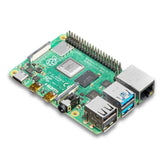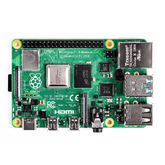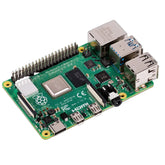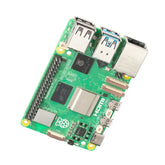5 Easy Ways to Connect Your Raspberry Pi Remotely – Guide for Makers
Summary
Whether you're running a home automation setup or tinkering with a headless project, remote access to your Raspberry Pi can make life a lot easier. The good news is that you don’t need fancy tools or deep networking knowledge to get started.
In this guide, we’ll walk through five reliable methods for Raspberry Pi remote access—from basic SSH to advanced internet-based options. If you’ve ever asked, “How can I access my Raspberry Pi remotely?”—you’re in the right place.
The Core Benefits of a Remote Raspberry Pi
Before detailing configuration procedures to enable remote access to a Raspberry Pi, understanding the benefits derived helps reveal why it's worth the effort:
- Accessibility from any internet-connected device no matter where the Pi or user is located geographically. This allows administering services and leveraging computing power without physical proximity.
- Centralized management wherein multiple internet-connected devices can utilize a single Raspberry Pi as a hub for shared resources, backups, automation tasks, etc via the cloud.
- Flexibility to visually interact with a Pi's desktop or solely send command instructions remotely depending on the connection method used. Headless configuration is also possible.
- Enhanced functionality around the clock by keeping a Raspberry Pi continuously online and accessible versus needing to hook up peripherals directly each use session.
With a world of possibilities opening up by linking your Pi to the internet soup, the methods below offer secure ways to bridge local devices to global connectivity.
Browse the Best Selection of Raspberry Pi Kits.
Method 1 - Command Line Access with SSH

The most basic means of gaining remote access to your Pi's command line interface is via SSH (Secure Shell). SSH utilizes encryption to establish secure terminal connections between network-connected devices. Using just an SSH client program like PuTTY and knowing your Pi’s local IP address, you can remotely access its Linux terminal to run commands and scripts as if typing on a keyboard plugged into the Pi itself.
Setting up SSH access requires enabling the built-in SSH daemon on your Pi, either via the Raspberry Pi OS configuration menu under “Interfaces” or by placing an empty file named “ssh” into the /boot partition folder. Once SSH is enabled and the Pi rebooted, check for connectivity by trying to SSH in from another system on the same local network.
With SSH functioning on a local network, accessing your Pi remotely over the internet involves additional routing configuration covered later in this guide. Nonetheless, SSH remains a vital tool for encrypted command line control no matter how near or far you roam from your homebase Raspberry Pi.
read more : Top 5 Raspberry Pi Projects for 2023
Method 2 – Graphical Control Using VNC

For intuitive real-time visual interaction with your Pi’s desktop, Virtual Network Computing (VNC) is the go-to solution. VNC transmits a live feed of your complete Pi desktop to another internet-connected device. Unlike SSH’s text-only terminal, VNC allows visually interacting with the Linux GUI, opening applications, editing files, tweaking configurations, and watching media playback remotely.
To enable VNC connectivity, the free utility TightVNC Server must be installed on your Pi via the command:
``` sudo apt install tightvncserver ```
Once installed, initiate the VNC server by running:
``` tightvncserver ```
This will configure a VNC password to connect clients. Having launched the VNC server, you can now remotely view and control your Pi’s desktop by downloading any VNC client, entering your Pi’s IP address, and connecting using the set password. The open source VNC Viewer application is an excellent cross-platform choice.
With VNC enabled, visual remote access is covered. But for Windows devotees, an even more deeply integrated method is also at your disposal.
Method 3 – Built-In Remote Desktop for Windows

Exclusive for Windows users is the option to access your Pi’s desktop through Microsoft's proprietary Remote Desktop Protocol (RDP). Raspberry Pi OS includes RDP server software out-of-the-box. Simply enabling RDP via the “Interfaces” tab in Raspberry Pi Configuration launches Remote Desktop hosting capabilities.
You can also manually activate RDP by editing the /etc/xrdp/xrdp.ini config file and changing port=3389 under the [xrdp1] section. With the RDP server operational after a reboot, Remote Desktop Connection built into Windows can remotely access the graphical Pi interface.
Connecting is identical to other RDP links – merely provide your Pi’s local IP address when prompted. Voila! Your Raspberry Pi environment mirrors onto the desktop like any remotely managed PC. RDP certainly simplifies graphical Pi connections for Windows devotees.
Method 4 - Port Forwarding for External Network Access

Up to this point, the remote access methods have assumed both devices are on the same local network. But what about accessing your Pi remotely when connected to different networks - especially from across the internet? This requires specific router configuration known as “port forwarding”.
By default, home routers block external requests as a security measure, only permitting outbound requests from LAN devices. Port forwarding creates firewall rules to allow specific incoming traffic by mapping designated ports to an internal IP address, like that assigned to your Raspberry Pi. Common ports like 22 for SSH or 3389 for RDP can be forwarded publicly such that external connection requests get routed through to your Pi.
Most home router admin dashboards include port forwarding menus. Adding rules to open a port involves specifying the inbound port number you wish to open, selecting connection protocol (TCP or UDP), then entering your Pi’s local IP address. Save your port forwards, and external traffic crossing those ports will traverse directly to your Pi!
But with dynamic IP addresses constantly shifting, how can anyone connect remotely without knowing your latest public IP? Dynamic DNS to the rescue!
Method 5 - Linking Dynamic IP to Static DNS

While port forwarding enables inbound remote access to local devices, dynamic IP addresses most home networks utilize still pose an issue. With your public IP likely changing periodically, maintaining access requires utilizing dynamic DNS (DDNS).
DDNS services bridge the gap by linking a static hostname like YourPi.ddnsprovider.com to your frequently shifting public IP address. Special client software on your Raspberry Pi refreshes this DNS record every time your public IP gets reassigned. The domain name thus acts as a fixed pointer always routing to your Pi regardless of background IP alterations.
Many excellent DDNS providers exist like DuckDNS offering free hostname domain pointing powered by easy-to-configure clients. Setting up DDNS along with port forwarding establishes reliable remote access from anywhere by using your Pi’s permanent domain.
With both techniques combined, your globally addressable Raspberry Pi awaits input virtually anywhere the internet spreads its reach!
Conclusion
Like an iceberg where 90% of its mass lies unseen beneath the surface, remotely accessing your Raspberry Pi unleashes capabilities and convenience otherwise dormant without remote connectivity. SSH, VNC, RDP, port forwarding, and DDNS each help realize secure remote Pi access via varied means with their own pros and cons. Employing one or more techniques opens the door to administering your Pi from anywhere, building location-independent services, and enjoying always-on convenience no matter where you or your Raspberry Pi resides.
Early on, accessing a Raspberry Pi remotely can seem involved. But the scope of possibilities unlocked makes the effort worthwhile. With so many guides and software tools available, setting up remote access need not be a challenging process, especially with the fundamental concepts and options covered here. By making your Pi globally accessible, you can focus more on leveraging its computing power rather than just connecting peripherals directly.
So waste no time in unleashing your Raspberry Pi’s fullest potentials – start connecting from across rooms or continents today! With remote access established, your Pi can server you wherever the internet reaches.
If you appreciate our work don't forget to share this post and leave your opinion in the comment box.
Please do check out other blog posts about Popular electronics
Make sure you check out our wide range of products and collections (we offer some exciting deals!)
Excerpt
Frequently Asked Questions
1. How do i connect my raspberry pi to wifi remotely?
To connect your Raspberry Pi to WiFi remotely, you can create a wpa_supplicant.conf file in the boot directory of your SD card. This file should contain your network SSID and password. When the Pi boots up, it will use this configuration to connect to your WiFi network automatically, allowing you to access it via SSH without needing a monitor or keyboard.
2. How do you remote connect to a windows pc from a raspberry pi?
Open a terminal window on your computer and type the following command, replacing "the_pi_IP" with the actual IP address of your Raspberry Pi:
3. How do i remotely connect to raspberry pi from ssh?
To connect to your Raspberry Pi via SSH, open a terminal on your computer (or use PuTTY on Windows). Type ssh pi@<YOUR_PI_IP_ADDRESS> and press Enter. You will be prompted for a password (default is raspberry). Once authenticated, you will have command-line access to your Pi.
4. How do i connect my raspberry pi to the internet?
To connect your Raspberry Pi to the internet, you can use either an Ethernet cable connected directly to your router or connect via Wi-Fi. For Wi-Fi, click the network icon in the top right corner of the desktop, select your network, and enter the password. Alternatively, you can configure Wi-Fi via the terminal using sudo raspi-config.
5. How to connect to vnc raspberry pi?
To connect via VNC, first enable VNC on your Raspberry Pi by going to Preferences > Raspberry Pi Configuration > Interfaces and switching VNC to 'Enabled'. Then, install VNC Viewer on your computer or phone. Enter your Pi's IP address into VNC Viewer, and log in using your Pi's username and password to see the desktop remotely.
How can I access my Raspberry Pi remotely from anywhere?
To access your Raspberry Pi remotely, use services like SSH or VNC over a Virtual Private Network (VPN). Setting up a VPN provides secure remote access without exposing your device to the internet. Dynamic DNS services can also help you connect without needing a static IP address.
What is SSH and how to enable it on Raspberry Pi?
SSH, or Secure Shell, is a protocol that allows secure remote access to your Raspberry Pi. To enable it, open the Raspberry Pi configuration tool via the terminal or graphical interface and navigate to 'Interfacing Options.' Toggle SSH to 'Enable' and reboot the device to start using it securely.
Can I control my Raspberry Pi remotely via VNC or RDP?
Yes, you can control your Raspberry Pi remotely using VNC or RDP. VNC allows you to manage desktop environments, while RDP can also be used for remote access. Install a VNC server on your Raspberry Pi, configure it, and use a VNC viewer on your client device for access.
How do I set up remote access for Raspberry Pi without exposing it online?
To set up secure remote access without online exposure, use a VPN. This creates an encrypted tunnel between your device and Raspberry Pi, minimizing security risks. Alternatively, configure port forwarding cautiously and limit access to specific IP addresses.
What are the security risks of remote Raspberry Pi connections?
Security risks include unauthorized access, data breaches, and malware installation. Exposing your Raspberry Pi to the internet can make it vulnerable to attacks. Always use strong passwords, enable firewalls, and consider a VPN for secure remote access to mitigate these risks.
How to connect Raspberry Pi to my phone as remote display/control?
You can connect your Raspberry Pi to your phone using VNC Viewer. First, install a VNC server on your Raspberry Pi, then download the VNC Viewer app on your phone. Enter the Raspberry Pi’s IP address and authenticate to control your device from anywhere.
Which remote access method is fastest for Raspberry Pi?
SSH is typically the fastest method for accessing the Raspberry Pi remotely, especially for command-line tasks. If you need a graphical interface, VNC is also quick but may be slightly slower due to image processing. Always optimize your network connection for the best performance.
How do I troubleshoot remote connection issues on Raspberry Pi?
To troubleshoot remote connection issues, first check your network connection. Ensure your Raspberry Pi is online and reachable via Ping. Verify your port settings for SSH or VNC, and confirm that any firewalls or security settings aren’t blocking access. Restarting your devices can also resolve many issues.
Can I remote upload code and files to Raspberry Pi from a different network?
Yes, you can remotely upload files to your Raspberry Pi using SCP (Secure Copy Protocol) or SFTP (SSH File Transfer Protocol). These methods allow you to transfer files securely as long as you have SSH enabled and know the device’s IP address or hostname.
What setup do I need to remotely access Raspberry Pi behind a firewall?
To access a Raspberry Pi behind a firewall, set up port forwarding on your router for SSH (port 22) or VNC. Additionally, configure your firewall to allow these connections. Using a VPN can further enhance security while giving you direct access to your Raspberry Pi.
1. How do i connect my raspberry pi to wifi remotely?
To connect your Raspberry Pi to WiFi remotely, you can create a wpa_supplicant.conf file in the boot directory of your SD card. This file should contain your network SSID and password. When the Pi boots up, it will use this configuration to connect to your WiFi network automatically, allowing you to access it via SSH without needing a monitor or keyboard.
2. How do you remote connect to a windows pc from a raspberry pi?
Open a terminal window on your computer and type the following command, replacing "the_pi_IP" with the actual IP address of your Raspberry Pi:
3. How do i remotely connect to raspberry pi from ssh?
To connect to your Raspberry Pi via SSH, open a terminal on your computer (or use PuTTY on Windows). Type ssh pi@<YOUR_PI_IP_ADDRESS> and press Enter. You will be prompted for a password (default is raspberry). Once authenticated, you will have command-line access to your Pi.
4. How do i connect my raspberry pi to the internet?
To connect your Raspberry Pi to the internet, you can use either an Ethernet cable connected directly to your router or connect via Wi-Fi. For Wi-Fi, click the network icon in the top right corner of the desktop, select your network, and enter the password. Alternatively, you can configure Wi-Fi via the terminal using sudo raspi-config.
5. How to connect to vnc raspberry pi?
To connect via VNC, first enable VNC on your Raspberry Pi by going to Preferences > Raspberry Pi Configuration > Interfaces and switching VNC to 'Enabled'. Then, install VNC Viewer on your computer or phone. Enter your Pi's IP address into VNC Viewer, and log in using your Pi's username and password to see the desktop remotely.
How can I access my Raspberry Pi remotely from anywhere?
To access your Raspberry Pi remotely, use services like SSH or VNC over a Virtual Private Network (VPN). Setting up a VPN provides secure remote access without exposing your device to the internet. Dynamic DNS services can also help you connect without needing a static IP address.
What is SSH and how to enable it on Raspberry Pi?
SSH, or Secure Shell, is a protocol that allows secure remote access to your Raspberry Pi. To enable it, open the Raspberry Pi configuration tool via the terminal or graphical interface and navigate to 'Interfacing Options.' Toggle SSH to 'Enable' and reboot the device to start using it securely.
Can I control my Raspberry Pi remotely via VNC or RDP?
Yes, you can control your Raspberry Pi remotely using VNC or RDP. VNC allows you to manage desktop environments, while RDP can also be used for remote access. Install a VNC server on your Raspberry Pi, configure it, and use a VNC viewer on your client device for access.
How do I set up remote access for Raspberry Pi without exposing it online?
To set up secure remote access without online exposure, use a VPN. This creates an encrypted tunnel between your device and Raspberry Pi, minimizing security risks. Alternatively, configure port forwarding cautiously and limit access to specific IP addresses.
What are the security risks of remote Raspberry Pi connections?
Security risks include unauthorized access, data breaches, and malware installation. Exposing your Raspberry Pi to the internet can make it vulnerable to attacks. Always use strong passwords, enable firewalls, and consider a VPN for secure remote access to mitigate these risks.
How to connect Raspberry Pi to my phone as remote display/control?
You can connect your Raspberry Pi to your phone using VNC Viewer. First, install a VNC server on your Raspberry Pi, then download the VNC Viewer app on your phone. Enter the Raspberry Pi’s IP address and authenticate to control your device from anywhere.
Which remote access method is fastest for Raspberry Pi?
SSH is typically the fastest method for accessing the Raspberry Pi remotely, especially for command-line tasks. If you need a graphical interface, VNC is also quick but may be slightly slower due to image processing. Always optimize your network connection for the best performance.
How do I troubleshoot remote connection issues on Raspberry Pi?
To troubleshoot remote connection issues, first check your network connection. Ensure your Raspberry Pi is online and reachable via Ping. Verify your port settings for SSH or VNC, and confirm that any firewalls or security settings aren’t blocking access. Restarting your devices can also resolve many issues.
Can I remote upload code and files to Raspberry Pi from a different network?
Yes, you can remotely upload files to your Raspberry Pi using SCP (Secure Copy Protocol) or SFTP (SSH File Transfer Protocol). These methods allow you to transfer files securely as long as you have SSH enabled and know the device’s IP address or hostname.
What setup do I need to remotely access Raspberry Pi behind a firewall?
To access a Raspberry Pi behind a firewall, set up port forwarding on your router for SSH (port 22) or VNC. Additionally, configure your firewall to allow these connections. Using a VPN can further enhance security while giving you direct access to your Raspberry Pi.












